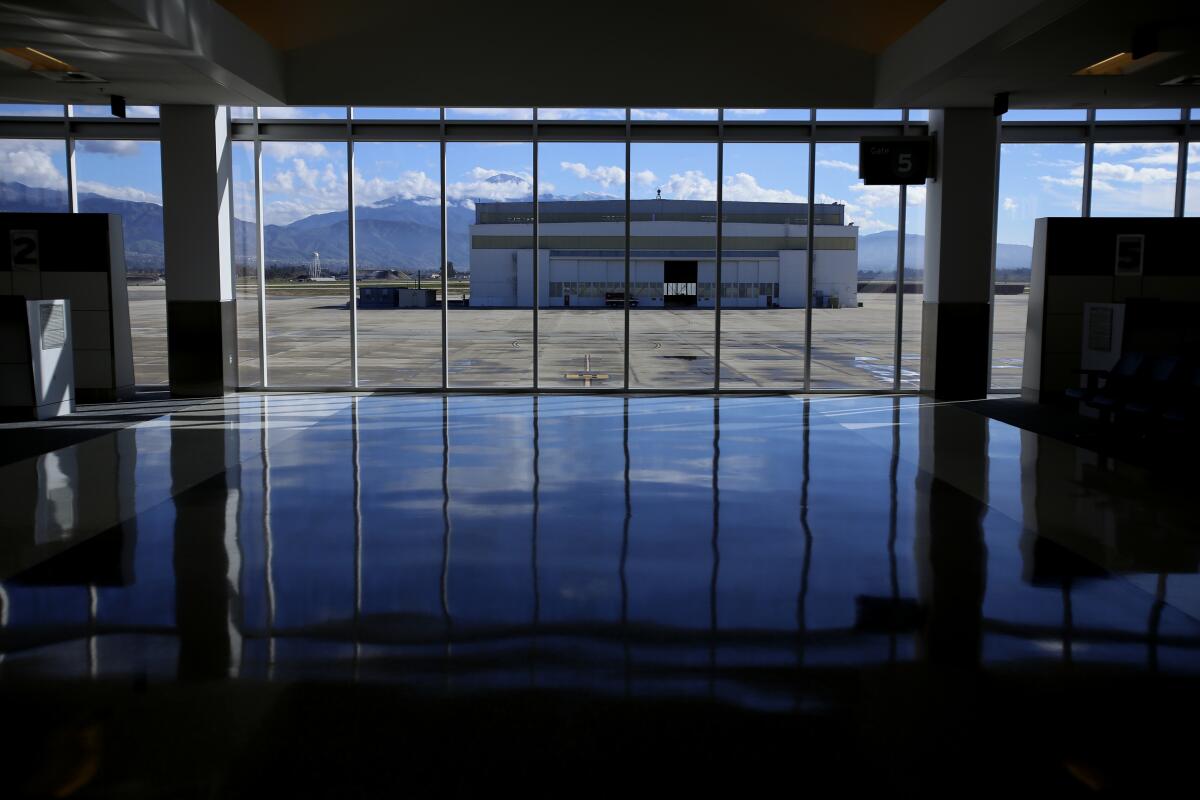Controversial San Bernardino airport cargo expansion approved

As many as 26 new cargo flights per day could come to San Bernardino International Airport after a controversial vote Monday gave final approval to a new $200-million air cargo facility
For the record:
7:59 p.m. Dec. 30, 2019An earlier version of this article said the San Bernardino International Airport Authority gave just over one day’s notice before Monday’s meeting. The agency announced the meeting on Friday. An earlier version also wrongly attributed a quote equating the air cargo expansion with “building a railroad yard in San Bernardino and connecting the United States.” It was said by John Magness, senior vice president of Hillwood, not by Michael Burrows, the airport commission’s executive director.
Boosters say the expansion, could eventually generate 3,800 jobs and $5 million in annual revenue for the publicly owned airport.
But local critics have questioned the value of yet another warehouse and logistics center in the Inland Empire, which has seen a boom in distribution centers in the last decade. Will the jobs be good jobs, or bring more low-paid work with no benefits? Are those jobs worth the increased pollution from planes and diesel trucks?
Those concerns sparked protests, culminating in a rally this month outside a fulfillment center operated by Amazon.com Inc. — the rumored occupant of the planned expansion. The e-commerce giant, which operates 14 logistics and fulfillment centers in San Bernardino and Riverside counties, declined to comment.
Then came Monday’s meeting of the San Bernardino International Airport Authority Commission, which voted unanimously to ratify the last details of a lease, allowing the project to move forward.
The agency announced the meeting Friday, just days before a state law takes effect Jan. 1 requiring local agencies to publicly disclose details about new warehouse distribution centers before a vote.
Under the lease agreement included in the meeting agenda, developer Hillwood Enterprises — which has created facilities at the airport for many large companies, including Amazon — will lease the space and could sublease it to a tenant. Commissioners had approved the bulk of the lease in December 2018, leaving a few procedural and minor technical details for Monday.
The project is the “equivalent of building a railroad yard in San Bernardino and connecting the United States,” said John Magness, senior vice president of Hillwood. “We’ll see freight and people and commerce coming from around the world. It’s an exciting time to see that come to the region.”
People crowded into the airport authority’s main auditorium Monday to say their piece before commissioners officially made their decision.
Andrea De Leon, executive director of the Highland Chamber of Commerce, voiced her support for the project and commended commissioners for an “exemplary job.”
“We have made this an exceptional product,” she said. “To not provide jobs is irresponsible.”
Jobs used to be scarce in the Inland Empire, but the rise of e-commerce paired with the nation’s economic recovery from the Great Recession created a boom in warehouse work in the region. The warehouse economy has brought 84,000 jobs to the area in the past decade — a quarter of all new jobs there since the recession. But many of those jobs pay close to the minimum wage, and workers still struggle to make ends meet. A February report by the Washington, D.C.-based Brookings Institution found that the Inland Empire consistently ranks close to the bottom on measures of prosperity and economic inclusion among large regions.
At past community meetings, residents and activists called on the airport authority to attach a rider known as a Community Benefits Agreement to any contract for a new cargo facility to set guidelines on air pollution and wages.
On Monday, opponents lambasted commissioners for holding a special meeting on short notice during the holiday season to push through the project, which they said should guarantee community benefits and be further vetted for environmental effects.
Abigail Medina, a San Bernardino City Unified School District board member, said that the community needs local union jobs but not at the expense of people’s health. “Diesel trucks are polluting our land,” she said. “Why the rush in between the holidays? It doesn’t make any sense.”
The Federal Aviation Administration issued its blessing for the project Dec. 23, finding no significant environmental impact.
“Sustainability and job creation are at the core of Hillwood’s values,” John Magness, a senior vice president at the Texas-based real estate developer, said in a statement.
Efforts by lawmakers to regulate the growing warehouse economy have focused on pollution and local agencies’ free hand with tax breaks for employers — under California law, cities are allowed to return part of sales tax payments to corporations as an incentive for building within their borders.
A law set to go into effect Wednesday requires local agencies to publicly report numerous details of any new warehouse distribution centers being built in the state, including the amount of any tax subsidies going to a new project, before voting to approve the projects. The bill also bars agencies from signing nondisclosure agreements with companies building these facilities — a practice that could explain why a prospective tenant at the new San Bernardino airport expansion has not been identified.
Monday’s vote took place just in time to avoid those new reporting requirements. Earlier this year, Michael Burrows, the airport commission’s executive director, said that the new facility includes no public subsidies.
Under the lease agreement, Hillwood would use a swath of the former Norton Air Force base the size of 11 football fields that could eventually see 26 flights a day. The company would build a 658,500-square-foot building for sorting air cargo; two 25,000-square-foot ground support buildings; about 41 acres of structural apron and taxi lanes for aircraft parking and positioning. The initial lease term is 35 years, with an initial payment of 24 months at $112,000 a month. The project also requires construction of two new bridge crossings onto 3rd Street and signal and traffic lane improvements.
Meanwhile, an effort by Riverside County officials to stop warehouses from encroaching on residential areas has fallen flat. County Supervisor Kevin Jeffries introduced a “good neighbor policy” that would put in place minimum standards for new warehouse projects, including a 1,000-foot buffer zone between large warehouses and homes. But by the time it reached a vote last month, Jeffries opposed it. He said it had been “gutted,” with the buffer zone reduced to just 300 feet between loading docks and residential property lines.
San Bernardino International Airport currently sees about 30 weekly cargo flights between UPS and FedEx, airport director of aviation Mark Gibbs said. That number increases to about 100 during the busy fourth quarter.
More to Read
Inside the business of entertainment
The Wide Shot brings you news, analysis and insights on everything from streaming wars to production — and what it all means for the future.
You may occasionally receive promotional content from the Los Angeles Times.












